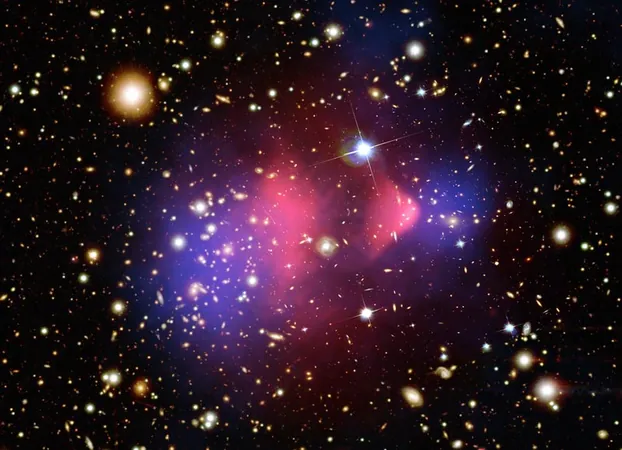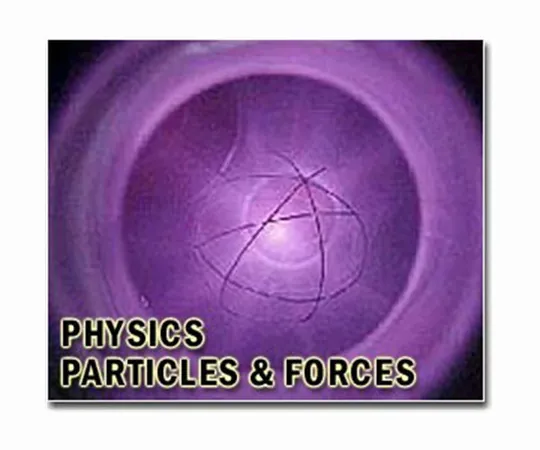
Groundbreaking Discovery: Are We Closing In on Dark Electromagnetism?
2025-05-14
Author: Siti
In a stunning breakthrough, physicists have placed a new upper limit on the interaction strength of dark matter by simulating the collision of two clouds of interstellar plasma. This groundbreaking research, conducted by teams from Ruhr University Bochum, CINECA in Italy, and the Instituto Superior Tecnico in Portugal, could dramatically reshape our understanding of dark matter, which is believed to constitute over 85% of the mass of the universe.
For centuries, dark matter has eluded our comprehension, mainly observable only through its gravitational effects. Theories abound regarding its composition, suggesting dark matter particles could possess masses ranging from a minuscule 10^-22 eV to an astronomical 10^19 GeV—an astounding 50 orders of magnitude!
The Mystery of Dark Charges
One of the most pressing questions surrounding dark matter is whether it interacts through forces other than gravity. Some scientists propose that dark matter particles could have 'dark charges'—positive and negative—that interact through 'dark electromagnetic forces.' This idea positions dark matter as a cold plasma of self-interacting particles, which is both fascinating and scientifically complex.
Unraveling the Bullet Cluster’s Secrets
The research team honed in on the Bullet Cluster, a cluster of galaxies several billion light years away, where two subclusters are moving apart after a high-speed collision. Using state-of-the-art computational tools traditionally reserved for studying electromagnetic interactions in normal plasma, the scientists examined potential dark interactions within the Bullet Cluster.
In previous studies, the same team analyzed standard plasma collisions, discovering that electromagnetic instabilities emerged as the clouds merged, redistributing energy and affecting temperature ranges.
A Game-Changing Result
The latest findings further revealed that while the plasma dynamics of the Bullet Cluster slowed due to standard electromagnetic interactions, there were no indications of additional dark interactions. As team member Kevin Schoeffler noted, this doesn’t eliminate the possibility of dark electromagnetic interactions but indicates they are significantly weaker than their ordinary counterparts. By calculating an upper limit for this interaction, the study challenges several existing dark matter theories.
This upper limit was set at < 4 x 10^-25 for a dark matter particle with a mass of 1 TeV, forcing scientists to rethink many of the simplest dark matter concepts. Schoeffler emphasized that this undertaking required innovative cross-disciplinary collaboration, communicating complex ideas across different scientific domains.
What’s Next for Dark Matter Research?
Looking ahead, the physicists aim to correlate their simulation outcomes with further astronomical observations to fine-tune the upper limit of dark electromagnetic interactions. More sophisticated calculations that account for intricate cloud models and additional plasma-like scenarios could yield even stronger constraints.
As we edge closer to unraveling the mysteries surrounding dark matter, groundbreaking research like this one opens new doors for exploration and understanding in the cosmos.




 Brasil (PT)
Brasil (PT)
 Canada (EN)
Canada (EN)
 Chile (ES)
Chile (ES)
 Česko (CS)
Česko (CS)
 대한민국 (KO)
대한민국 (KO)
 España (ES)
España (ES)
 France (FR)
France (FR)
 Hong Kong (EN)
Hong Kong (EN)
 Italia (IT)
Italia (IT)
 日本 (JA)
日本 (JA)
 Magyarország (HU)
Magyarország (HU)
 Norge (NO)
Norge (NO)
 Polska (PL)
Polska (PL)
 Schweiz (DE)
Schweiz (DE)
 Singapore (EN)
Singapore (EN)
 Sverige (SV)
Sverige (SV)
 Suomi (FI)
Suomi (FI)
 Türkiye (TR)
Türkiye (TR)
 الإمارات العربية المتحدة (AR)
الإمارات العربية المتحدة (AR)